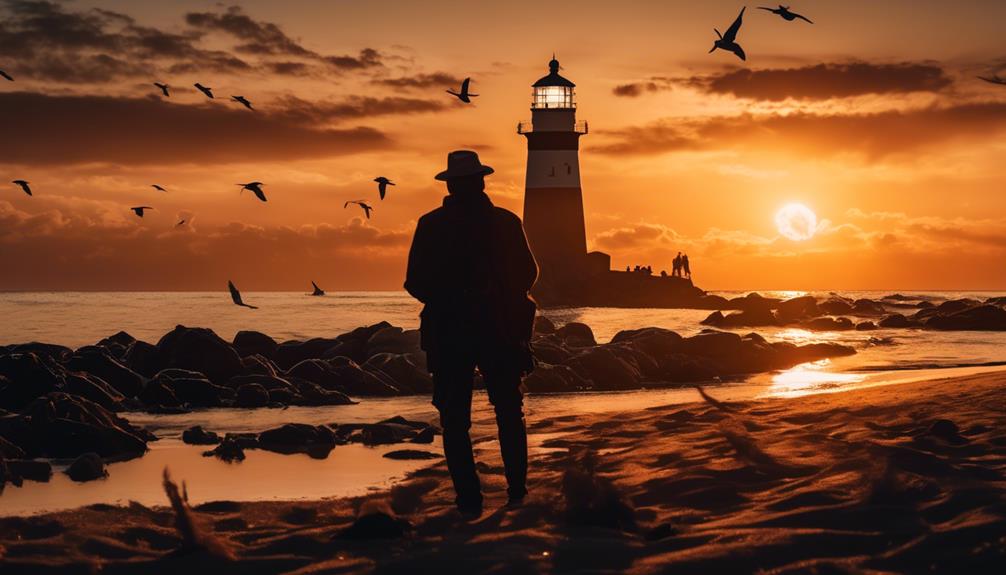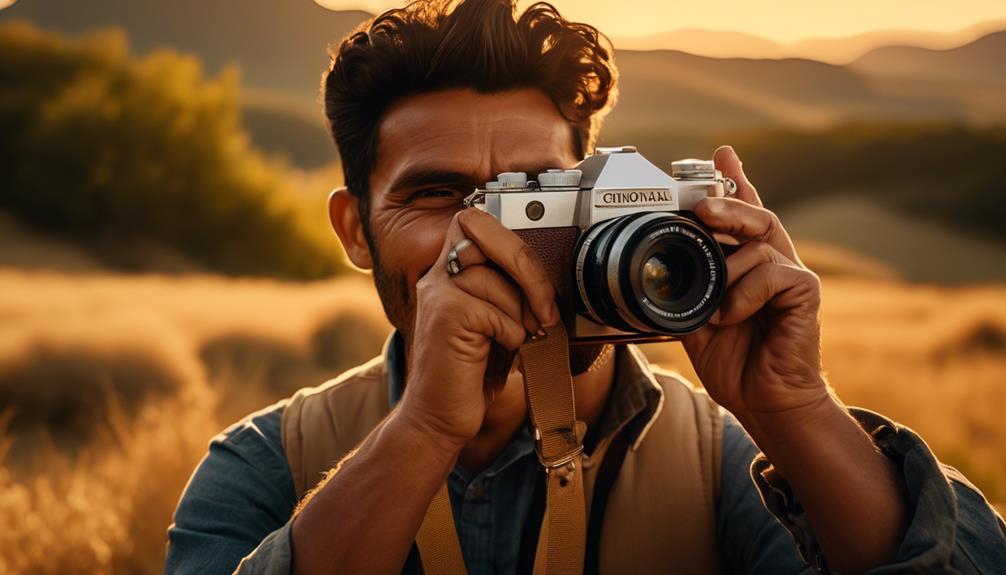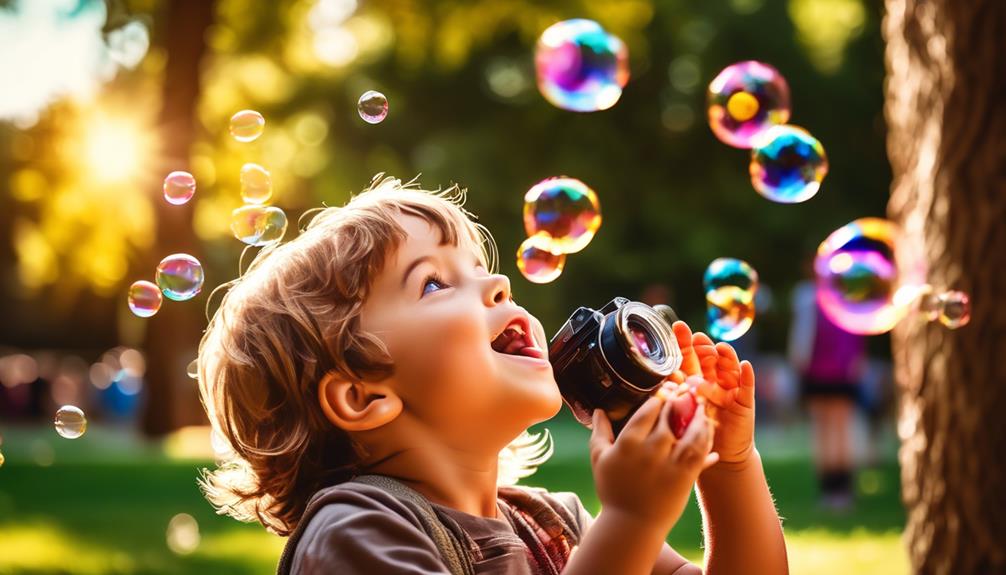Please note this post may contain affiliate links picked by me (Jay) that I have deemed may be of interest or relevant to you the reader of this.
These links do not affect the cost of the thing if you decide to purchase but i may get a little money if you choose to purchase.
For more information on my affiliate link policy click here.
As a photographer, I've always believed that every image has a story to tell. Behind every click of the shutter lies a world of emotions, narratives waiting to be unraveled. It's like holding a key that unlocks the hidden depths of a moment frozen in time.
But how do we elevate our photography and truly capture the essence of a story? How do we go beyond the surface and delve into the heart of our subjects?
In this discussion, we will explore the art of storytelling through photography, uncovering techniques that will transform your images into powerful narratives that leave a lasting impact.
Key Takeaways
- Expressive gestures and candid moments can capture and convey emotions without words.
- Manipulating light and shadow can create mood and atmosphere in photographs.
- Incorporating visual elements, such as symbolism and creative framing, adds depth to the narrative.
- Posing and directing subjects and utilizing the environment can enhance storytelling in photography.
Capturing Emotion Through Composition
When capturing emotion through composition, I bring the viewer into the heart of the moment, using the power of visual storytelling to evoke a profound and authentic connection. Photography isn't just about capturing a scene; it's about capturing the essence of that moment, the raw emotions that unfold in front of the lens. To achieve this, I focus on capturing expressive gestures and candid moments that reveal the true essence of the subject.
Expressive gestures are the subtle movements and body language that convey emotions without the need for words. These gestures can be as simple as a smile, a tear, or a clenched fist. By capturing these gestures, I'm able to freeze a moment in time, allowing the viewer to experience the same emotions as the subject. It's through these gestures that the story comes to life, creating a connection between the viewer and the photograph.
Candid moments, on the other hand, capture the raw and unfiltered emotions of a subject. These are the moments when people forget about the camera and let their true selves shine through. Whether it's a joyful laugh, a contemplative gaze, or a tearful embrace, candid moments capture the authenticity of a person's emotions. By being present in these moments and capturing them with my camera, I'm able to share the emotional journey of the subject with the viewer.
Innovative photography isn't just about capturing a beautiful image; it's about capturing the emotions that lie beneath the surface. Through expressive gestures and candid moments, I'm able to create a visual narrative that transports the viewer into the heart of the moment. It's through this emotional connection that the power of visual storytelling truly comes alive.
Using Light and Shadow to Convey Mood
As I continue to explore the art of capturing emotion through composition, I've discovered that harnessing the interplay of light and shadow is a powerful tool in conveying mood. The contrast and atmosphere created by the manipulation of shadows can evoke a wide range of emotions, from mystery and intrigue to serenity and melancholy.
When I first began experimenting with light and shadow, I was amazed at how the slightest adjustments could completely transform the mood of a photograph. By strategically placing my subject in the path of the light, I could create bold contrasts that added drama and intensity to the scene. The sharp edges of the shadows added depth and dimension, drawing the viewer's eye to the focal point and creating a captivating visual story.
In addition to contrast, the atmosphere created by manipulating shadows can greatly enhance the overall mood of a photograph. By softly diffusing the light or casting long, eerie shadows, I could create a sense of mystery and intrigue. On the other hand, by using gentle, diffused light and soft shadows, I could convey a feeling of tranquility and serenity.
As a photographer, it's important to constantly experiment and push the boundaries of creativity. Incorporating light and shadow into your compositions allows you to add depth, create visually striking images, and convey a specific mood or emotion.
Incorporating Visual Elements for Narrative Depth
Incorporating visual elements into your photographs is essential for adding narrative depth and elevating your storytelling. By utilizing symbolism in photography and employing creative framing techniques, you can take your viewers on a visual journey that captures their imagination and leaves a lasting impression.
Here are four ways to incorporate visual elements for narrative depth:
- Symbolism: Symbolism in photography allows you to convey complex emotions and ideas through the use of objects, colors, or even gestures. A single image can speak volumes when a well-chosen symbol is incorporated, evoking a sense of mystery and intrigue.
- Creative framing techniques: Experimenting with different framing techniques can enhance the storytelling aspect of your photographs. Whether it's through framing your subject within a natural frame, like a window or archway, or using unconventional angles to create a unique perspective, creative framing techniques can add depth and dimension to your composition.
- Use of leading lines: Leading lines are a powerful tool for guiding your viewers' eyes through the image, creating a visual narrative. By strategically placing lines in your composition, such as a road, a fence, or even a row of trees, you can lead your viewers towards the main subject or create a sense of movement within the frame.
- Contrast and juxtaposition: Contrast and juxtaposition can be used to create visual tension and highlight the narrative elements in your photographs. By placing contrasting elements side by side, such as light and dark, old and new, or big and small, you can create a dynamic composition that sparks curiosity and invites viewers to explore the story behind the image.
Incorporating visual elements for narrative depth in your photography requires a keen eye for detail and a willingness to think outside the box. By embracing symbolism, experimenting with creative framing techniques, utilizing leading lines, and exploring contrast and juxtaposition, you can elevate your storytelling and captivate your audience with innovative and compelling visual narratives.
Posing and Directing Subjects for Storytelling
Building upon the foundation of incorporating visual elements for narrative depth, I now turn to the art of posing and directing subjects to further enhance the storytelling aspect of your photographs. Posing and directing subjects is a powerful tool that allows photographers to create compelling and captivating narratives. By guiding subjects to express themselves through their body language, we can convey a wide range of emotions and add depth to our visual stories.
Expressive gestures are key to conveying emotions through body language. A simple tilt of the head, a gentle touch of the hand, or a subtle shift in posture can speak volumes. As photographers, it's our responsibility to direct our subjects and help them tap into their emotions, enabling them to communicate their story through their physical presence. By doing so, we bring life and authenticity to our images, allowing viewers to connect on a deeper level.
Another technique that can enhance storytelling is environmental storytelling. By utilizing the surroundings, we can create a richer narrative that goes beyond the subject alone. The environment can provide context, add layers of meaning, and contribute to the overall story we want to convey. Whether it's a bustling city street, a serene natural landscape, or an intimate indoor setting, the environment can become a character in its own right, helping to shape and define the narrative.
Innovative photographers understand the importance of posing and directing their subjects to tell a story. Through expressive gestures and environmental storytelling, we can create images that captivate and engage our audience. So, the next time you pick up your camera, remember to not only focus on the technical aspects but also on the power of posing and directing. Let your subjects speak through their body language, and let the surroundings play a supporting role in your visual storytelling journey.
Editing Techniques to Enhance the Narrative
To truly bring a narrative to life, the art of editing plays a vital role in enhancing the storytelling within a photograph. It's through editing that we can transform an ordinary image into a captivating visual tale. So, let's dive into some editing techniques that can truly elevate your photography narrative:
- Color grading for visual storytelling: Color is a powerful tool that can evoke emotions and set the mood of a photograph. By carefully manipulating the hues, saturation, and contrast, you can enhance the narrative of your image. Whether it's desaturating to create a nostalgic feel or boosting vibrant colors to convey energy, color grading allows you to guide the viewer's emotions and immerse them in the story.
- Creative use of filters in post-processing: Filters are a fantastic way to add a touch of creativity and uniqueness to your images. From vintage film effects to dreamy softening filters, these tools can help you create a specific atmosphere or style that enhances the narrative. Experimenting with different filters can open up a whole new world of possibilities and allow you to express your vision in innovative ways.
- Selective cropping to focus the story: Sometimes, the key to enhancing the narrative lies in what you choose to exclude. By selectively cropping your image, you can eliminate distractions and guide the viewer's attention to the most important elements of the story. Whether it's zooming in on a subject's expression or removing irrelevant background elements, thoughtful cropping can strengthen the impact of your narrative.
- Sequencing for a cohesive story: If you're working on a series of photographs to tell a story, the order in which you present them can greatly influence the narrative. Consider the flow, pacing, and transitions between images to create a cohesive and engaging visual journey. Experiment with different sequencing options until you find the arrangement that best conveys your intended story.
Frequently Asked Questions
How Can I Capture Emotion Through Composition in My Photography?
To capture emotion through composition in my photography, I dive into the power of color and storytelling.
By carefully selecting and arranging elements within the frame, I can evoke a range of emotions in my viewers.
Whether it's using warm tones to convey happiness or cool tones to evoke a sense of melancholy, the composition becomes a language that speaks to the soul.
Exploring this art form allows me to create innovative and captivating photographs that truly connect with my audience.
What Are Some Techniques I Can Use to Convey Mood Through the Use of Light and Shadow in My Photos?
To convey mood through light and shadow in my photos, I employ various techniques.
Firstly, I use color temperature to create a specific atmosphere. Warm tones evoke a sense of coziness and intimacy, while cooler tones can convey a sense of loneliness or mystery.
Additionally, I utilize negative space strategically to enhance storytelling. By leaving areas empty, I can emphasize the subject and create a sense of focus or isolation.
These techniques add depth and emotion to my photographs, elevating the storytelling experience.
How Can I Incorporate Visual Elements to Add More Depth to the Narrative in My Photography?
To incorporate visual elements and add depth to the narrative in my photography, I focus on visual storytelling and creative composition.
By carefully selecting and arranging the elements within the frame, I can guide the viewer's attention and evoke emotions.
I experiment with different angles, perspectives, and framing techniques to create a captivating narrative.
Incorporating leading lines, symmetry, and contrasting colors helps me create visually compelling images that tell a story and leave a lasting impact on the viewer.
What Are Some Effective Ways to Pose and Direct Subjects in Order to Tell a Compelling Story Through My Photos?
When it comes to telling a compelling story through photography, creative posing and directing the narrative are essential.
By creating dynamic and engaging poses, I can add depth and emotion to my images.
Techniques such as guiding my subjects to convey specific stories or emotions through their actions and expressions can make my photos truly impactful.
It's all about capturing the right moments and using visual storytelling to create a unique and innovative experience for my audience.
What Editing Techniques Can I Use to Enhance the Narrative and Storytelling Aspect of My Photography?
Color grading techniques are a powerful tool to enhance the narrative in my photography. By manipulating colors, I can create a specific mood or atmosphere that aligns with the story I want to tell.
For example, using warm tones can evoke feelings of nostalgia or happiness, while cooler tones can convey a sense of calm or mystery.
Additionally, visual storytelling can be achieved by using elements such as composition, lighting, and framing to guide the viewer's eye and emphasize the narrative in my photos.
Conclusion
In conclusion, storytelling techniques are key to elevating photography to a whole new level. By capturing emotion through composition, using light and shadow to convey mood, incorporating visual elements for narrative depth, and posing and directing subjects for storytelling, photographers can create images that truly tell a story.
And with the right editing techniques, the narrative can be enhanced even further. So, embrace these techniques and let your passion and knowledge shine through your expressive and captivating photographs.


